1984 British Grand Prix race report - A four-ring circus
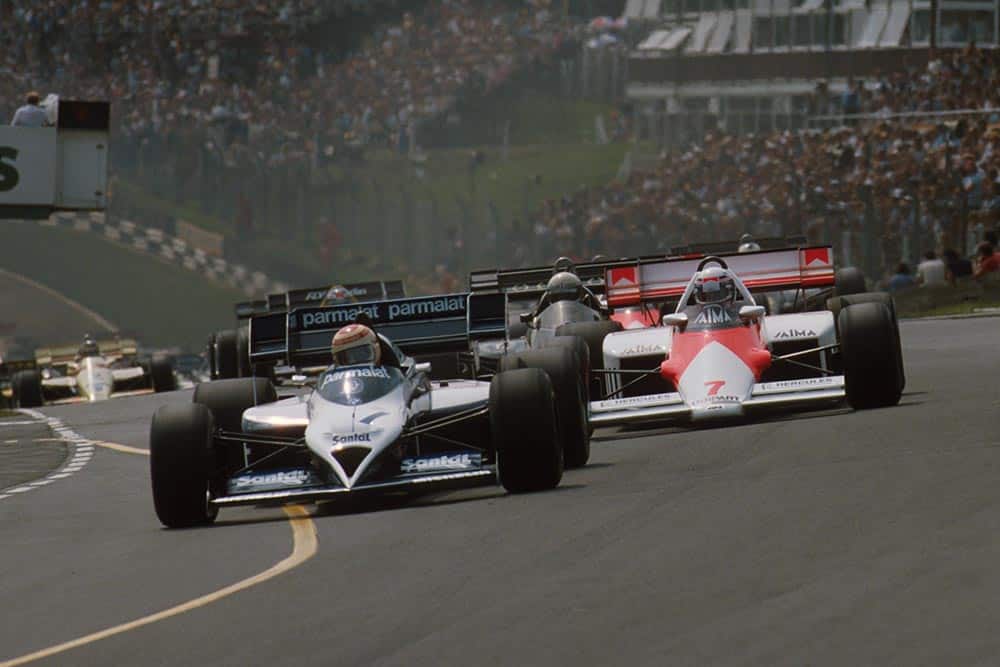
Nelson Piquet, Brabham BT53, leads the start.
© Motorsport Images
A four-ring circus
After the Demolition Derbies in Detroit and Dallas the Formula One “circus” must have breathed a sigh of relief when they returned to Europe to start some serious Grand Prix racing. The Brands Hatch circuit, scene for the 1984 British Grand Prix, may not be the best in the world for Formula One cars but at least it is quick and challenging in its own small way, with a lap speed of over 130 mph for the really fast drivers. When you look at a map of Brands Hatch it seems to be all corners and curves, with negligible straights so that you wonder how the front runners can possibly be lapping at over 130 mph. A speed trap at the start / finish line in practice indicated how it is possible, for the Brabham, Lotus, Ferrari, Renault and Williams cars were all recording well over 170 mph on the short undulating straight past the pits, having come out of Clearways corner at 130 mph or more. The high-speed acceleration of today’s Grand Prix car makes the eyes water just to think about it. The highest speed recorded over the start / finish line during practice and qualifying was 177 mph by de Angelis in a Lotus-Renault. On race day, under race conditions, most cars were 10 mph slower, including the Lotus.
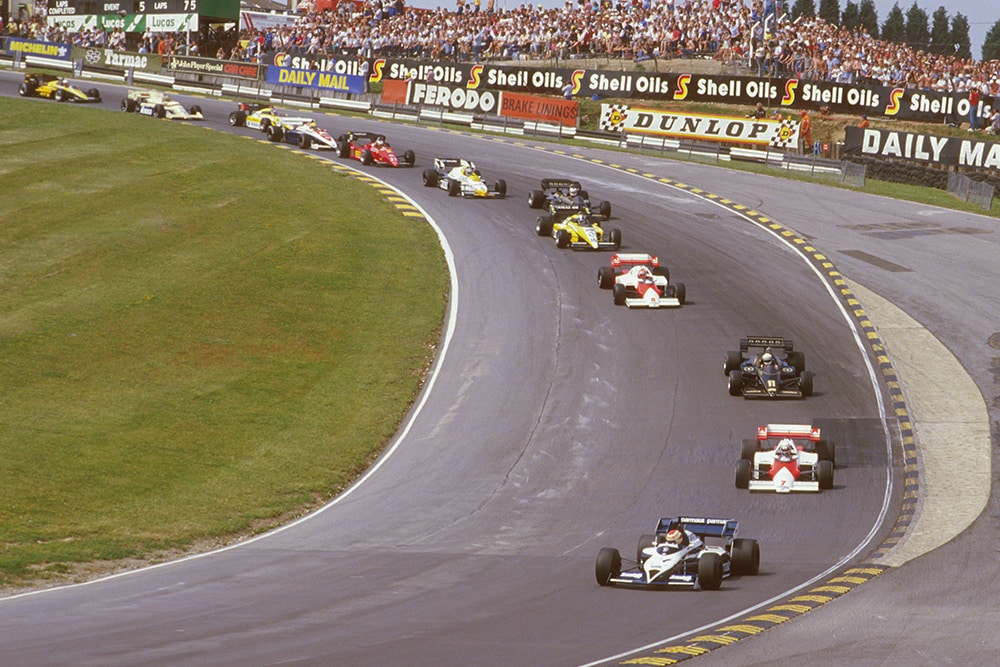
Nelson Piquet (Brabham BT53 BMW) leads Alain Prost (McLaren MP42 TAG Porsche), Elio de Angelis (Lotus 95T Renault), Niki Lauda (McLaren MP42 TAG Porsche), Derek Warwick (Renault RE50) and Nigel Mansell (Lotus 95T Renault) at the start through Paddock Hill Bend.
© Motorsport Images
As always, Brands Hatch had the circuit all set up and in prime condition for this great event, which was to attract a record crowd thanks to pre-race publicity and the interesting nature of the Grand Prix season so far, and practice got under way at 10 am on Friday morning in warm and dry conditions but under a thickly overcast sky. In spite of the workers of the world striking and unions causing disruption, the racing world worked overtime and got everyone and everything to the Kentish circuit on time even if some things were not as tidy and orderly as they could have been. As always the teams had been working flat-out since their return from the USA and Renault had a brand new car for Warwick (RE50/08) with structural improvements, while RAM had built a new car to replace the one destroyed by Alliot in Dallas, and Osella had built a third car in their V8 turbocharged Alfa Romeo-engined series for Jo Gartner, who was returning to the scene.
The Toleman team had completed a fourth car in their 1984 series and this was for Johnny Cecotto. The Brabham team had modified their BT53 cars to a B-specification which included many improvements developed over the first part of the season, including a more steeply mounted intercooler and radiator in the side pods, which entailed new fairings and new intakes, and the rear suspension had been modified. The Williams team appeared with their three cars in “B-spec” which involved “waisted” side pods at the rear, like the McLaren MP4/2, a longer oil tank casting between the engine and gearbox, which gave a five inch longer wheelbase, and modified rear suspension. Ferrari had four cars in attendance, two as raced previously and two with different radiator mountings in the side pods, and square air entries with large exits on the top, rather than the previous sharper angled pods. Alboreto and Arnoux had one of each type to experiment with.
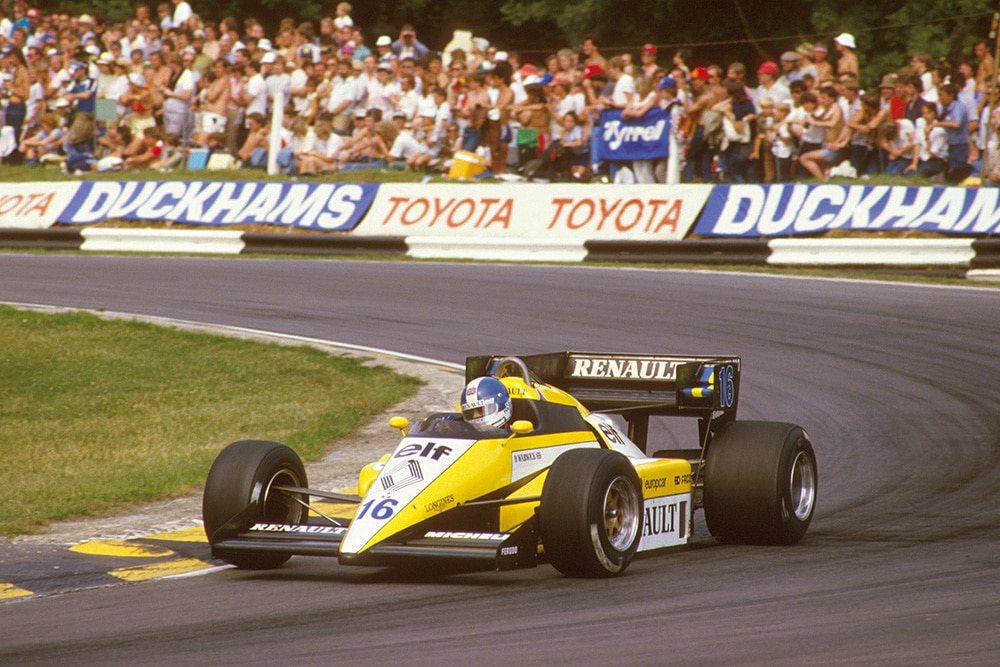
Derek Warwick exits Druids in hisRenault RE50.
© Motorsport Images
The day before practice began Team Tyrrell had been banned from all further participation in the World Championship series by the governing body of international motor racing, for a number of infringements of rules concerning the carrying of ballast and pit stops. The rights and wrongs of the case will come out later, but Ken Tyrrell applied The Treaty of Rome, The Strasbourg Convention, The Geneva Convention on Human Rights, The Court of Personal Justice, and the East Horsley Labour Party Workers’ Rights Articles of Administration, and a High Court Judge ruled that his cars could take part in the British Grand Prix. FISA stepped back and handed the responsibility to the RAC Motorsports Association, mentioning that the World Championship series belonged to FISA and Team Tyrrell were still being thrown out of that. The whole Tyrrell scene these days is a sad one, when you look back to the great days of Jackie Stewart, but the saddest part for many people was that Martin Brundle was unable to take part in his own GP due to his broken ankles suffered in his crash at Dallas. As a temporary replacement Tyrrell had signed up Stefan Johansson to join Bellof in the last stand of the unsupercharged Cosworth-engined cars.
Practice had only been going for four minutes when everything stopped. Cecotto had crashed very badly at Westfield Bend in his brand new Toleman and marshals were having difficulty getting him out of the wreckage. He was eventually flown to hospital by helicopter suffering from severe ankle injuries, and after the Armco barriers had been repaired, practice resumed. As a consequence of this, the morning session was reduced from an hour and a half to one hour and the all-important qualifying hour was put back from 1 pm to 2 pm. Not a good start to a three-day programme of events and a time-schedule that would take many business firms a year to accomplish. There were all the usual dramas, real and imaginary, with drivers either elated or depressed, depending on their lap times and a rosy glow was emanating from the far end of the pit lane for Ayrton Senna was not only going very quickly in the Toleman-Hart but had made fastest time of the morning, heading Prost and Lauda with the standard-setting McLaren-Porsches. The Renault team were floundering about a bit, Lotus were near the front as usual, Ferrari were there or there-abouts, but Brabham were in real trouble for their new “tweaks” were not giving the expected results.
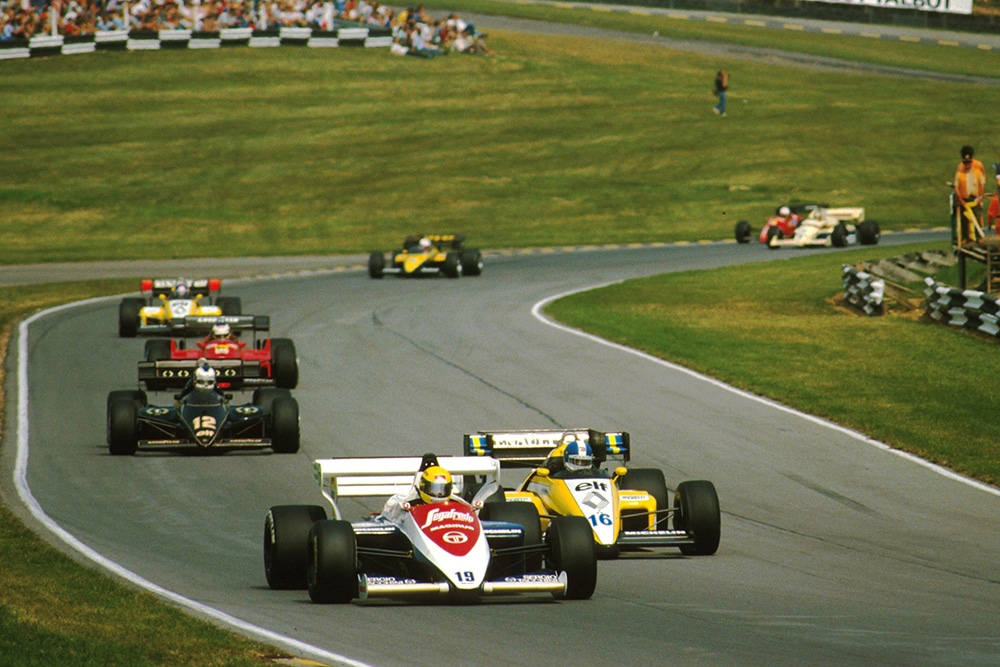
Ayrton Senna in 3rd in his Toleman TG184.
© Motorsport Images
In the serious one hour session when times were counting for grid positions, the scene did not change a great deal, though Prost and Lauda asserted themselves at the front and de Angelis showed that the Lotus 95T lacks nothing as a car, but most interesting was the fact that Senna’s speed in the morning had not been a fluke. He repeated the effort in the afternoon and scored fourth fastest, overall, admittedly while Piquet was still in trouble, Warwick was out very late and only got in one quick lap, Ferrari were not their usual selves and Roserg was unhappy with his WilliamsHonda. Nonetheless, Senna’s performance was up with the best, in the 1 min 11 sec bracket, with only Prost, Lauda and de Angelis ahead of him. Obviously neither the Toleman chassis nor the Hart engine were lacking anything, and it is very interesting that Senna seems to have started his career with the Toleman team at about the level at which Derek Warwick left off. Apart from Piquet being in real trouble with the modified Brabham, there were no real surprises down the list of runners, the tail-enders still being at the end; the mid-field runners being in the middle, and all things looked pretty orderly.
Apart from engines blowing up, turbo-chargers failing, potential race-winners (in their own view) being held up by slow cars, cars being “off the pace” whatever that may mean, drivers not driving at their best, Michelin tyres being better than Goodyear and vice-versa and so on and so forth, the qualifying scene was much as always, apart from that Toleman-Hart in fourth place, which was interesting. Saturday’s practice and qualifying appeared to be going on as the previous day, under clouded skies behind which a very hot sun was lurking. However, behind the scenes things had been happening, especially in the Brabham pits for Gordon Murray had quickly cut his losses on his “B-spec” car and a long session of work (no union rules in the Ecclestone world) by the Brabham mechanics had put the cars back to normal BT53 specification, retaining some of the rear suspension improvements. The result was electrifying for Piquet was immediately up among the front runners and was soon setting the pace ahead of the two McLarens. Senna was still there, but Renault and Ferrari were still in trouble and the French team’s problems were added to by Warwick sliding off into the catch fencing when his car grounded at the top of a rise on the back of the circuit, which put it into a pitching movement, and took the car out of his grasp.

Marc Surer driving his Arrows A7 BMW.
© Motorsport Images
During the break before the final qualifying hour the cloud base broke up and a very hot sun appeared, which was fine for the vast crowd of spectators who were enjoying all the pleasure and leisure provided by the Brands Hatch organisers, and there was a lot of it, but it was a headache for the engineers who had made all their guesses and their settings for the cooler overcast conditions. Those who really know their business are not put off by such simple things as a sudden rise in ambient temperature, and it was not long before a satisfactory pattern appeared that bore complete confirmation of reality. Piquet was fastest, in a bracket of his own with 1 min 10.869 sec (132.7 mph), Prost, Lauda, de Angelis, Rosberg and Warwick were lined up behind the World Champion, all in the 1 mm 11 sec bracket and then came the rest. In this final session Senna was down in thirteenth place, but his Friday time put him up into seventh place, just behind Warwick and in the 1 mm 11 sec elitist bracket, all of whom had lapped at over 130 mph, which is still remarkable bearing in mind the slow parts of the track.
Last on the list of 27 runners was Gartner with the new Osella, and as the High Court Judge affair over the Tyrrell suspension was still a bit problematical as far as the actual race was concerned, the Stewards of the meeting obtained the agreement of all the teams to allow 27 cars to start the race, thus obviating any justifiable grievance that Enzo Osella may have felt, at being excluded by having possibly “illegal” cars in the race in the shape of the two Tyrrells.
The two practice days had been very full with practice for supporting events, supporting races themselves, hilarious “chat-shows” for the Press by FISA and Team Tyrrell, wining and dining, extravagance on the part of sponsors, hospitality, entertaining, rip-offs and rackets, hustle and bustle, huge crowds, buying and selling, all the fun of the fair and Derby Day and all in a most happy atmosphere.
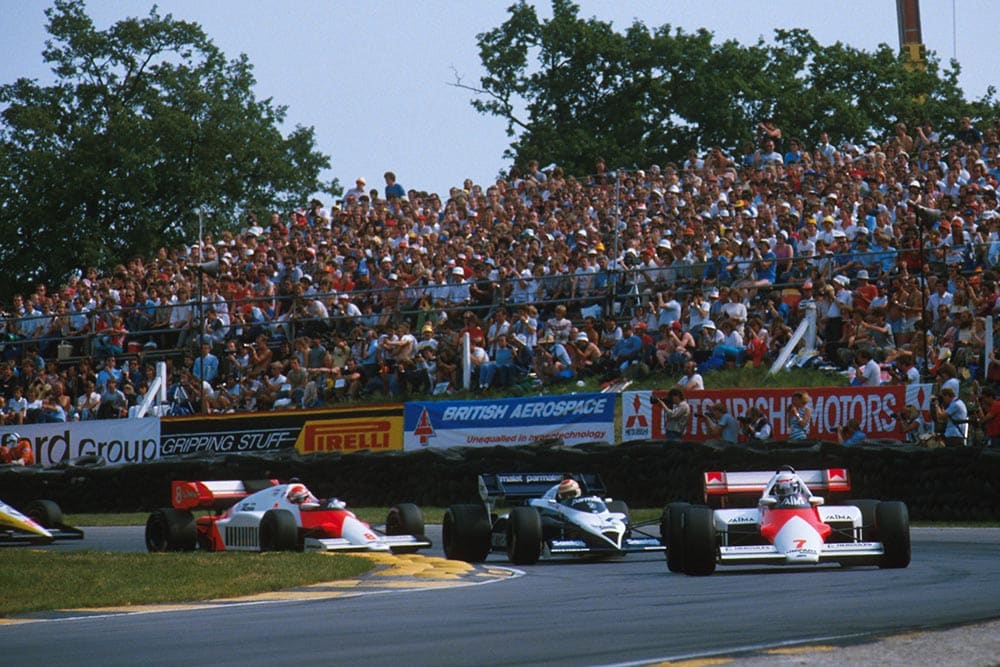
Alain Prost in his McLaren MP4/2.
© Motorsport Images
The Sunday morning traffic heading for the quiet corner of Kent in which the Brands Hatch valley is situated was unbelievable and car parks were full, as were the overflow parks, and cars were abandoned on the grass verges for miles in all directions. It was a warm and sultry start with the promise of being a splendid day and everyone seemed to be heading for the “fairground” in the right frame of mind. In previous years, Brands Hatch has been full at around 70,000 people, but this year the figure was far in excess of this and was probably nearer 90,000 and somehow they were all packed in, ready and waiting for things to happen. When the day did start it was non-stop action in all directions, on the track, in the air, on the grass, behind the scenes, in front of scenes, over the trees, behind the trees, out in the open, behind locked doors, it was happening everywhere. It was impossible not to find something happening.
The circus was in full flight, with four rings going on at the same time. As a feat of organisation by the RAC Motorsport Association and all its member clubs and club members it was a monument to enthusiastic effort, and then at a little before 3 pm on Sunday afternoon it all stopped and the only movement was the gentle swaying of advertising balloons on their tie-ropes. Jonathan Palmer had put a stop to the whole fantastic affair by crashing his RAM-Hart car into the tyre barriers coming out of Clearways bend onto the pits straight. He was unhurt but the car had its front end smashed off and the wreck lay on the grass in what the chief corner-observer decided was a vulnerable position so the British Grand Prix was stopped after 11 laps. For about 45 minutes the whole steaming affair of the British Grand Prix fizzled out into total silence. Not the uneasy silence associated with a bad accident, where you await the outcome, but a bored silence while the mess is being cleared up after someone has been sick on the best carpet!

Nigel Mansell in his Lotus 95T Renault.
© Motorsport Images
The morning warm-up session had gone well, the McLaren team were looking as strong as ever, Piquet was confident, Warwick was happier, Senna was enjoying everything, Mansell was whining, de Angelis was looking surly, Tarnbay was beaming in spite of being too far down the grid, the Ferrari team had the grey look of Italians who don’t understand, Tyrrell’s silly grin had gone from his face, Cheever and Patrese were wondering how they had made such a mistake as to join Alfa Romeo, Laffite was beginning to wish he had retired last year, Rosberg was doing his utmost as always and Gartner was pleased to be allowed to race. Everything was normal and amid the confusion of air displays, supporting races, demonstrations, parades, marching bands, flag waving and the side-shows, the count-down for the 1984 British Grand Prix began.
Piquet led the field of 27 cars round on the parade lap from his pole-position on the grid and the enormous crowd waited expectantly for the start of the big event. It was a good clean start and the blue and white Brabharn led down Paddock Hill, followed by Prost and de Angelis. Piquet was away and waiting for no-one, with the pack hard after him, but down the hill from Druids hairpin the tail-enders got into a terrible mess, caused by “chain-reaction”. Patrese was trying to make up for his poor grid position and got a bit crossed up as he went into the bend onto the bottom straight, and Cheever who was right behind him braked, as did Gartner and Johansson who were following, but Alliot did not have Patrese in his vision and knew nothing of what was happening ahead, and ran into them.
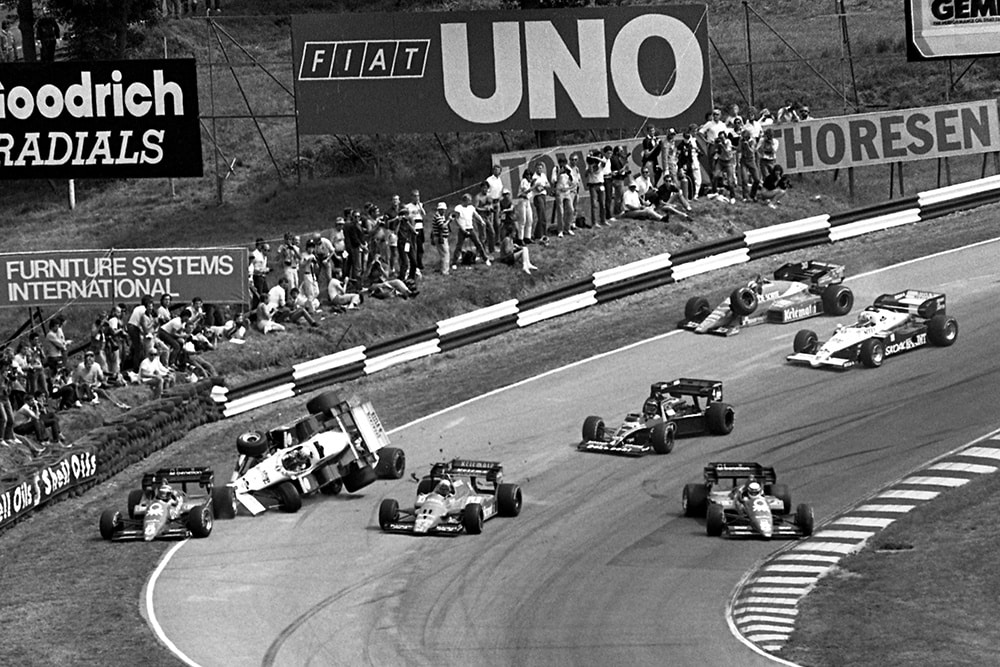
Riccardo Patrese’s Alfa Romeo 184T, snapped sideways leading to a multi-car accident on the first lap.
© Motorsport Images
The outcome was the Osella stuffed into the barriers, the RAM off on the grass after somersaulting, Cheever’s Alfa with a smashed in rear-end, and Johansson’s Tyrrell likewise smashed in at the back. While the Tyrrell managed to get back to the pits, the Alfa succumbed, and at the end of the first lap the field was down 23. As my Irish friend said “We ought to cut out these first laps, they’re too dangerous. Start the race on lap 2 like we do in Dublin”. Up at the front there was some pretty serious racing going on, with Piquet leading Prost and Lauda, the three of them pulling away from the rest who were led by Warwick. After only five laps Rosberg pulled out of the race and headed for the pits with trouble in his Honda engine, and Teo Fabi’s BMW engine was going on the blink with electrical trouble. Winkelhock spun off, or was spun off by someone else, along the bottom straight and by ten laps a pattern had formed that was looking good. The two McLarens were pressuring Piquet and he was having to over-stress his Michelin tyres to stay ahead of the German-powered cars from Woking, even though they were also on Michelin tyres. As Prost began to have a go at the Brabham, Lauda was right behind watching closely. Piquet parried the thrust twice, but on the third occasion Prost got by on Paddock Bend as they started lap 12, and Lauda followed through as they went up the hill to Druids.
Just at that moment Palmer came round Clearways onto the pits straight, lying in 17th place, with only Bellof, Hesnault and Rothengatter behind him, and ran wide onto the grass and thumped the tyre wall and the Armco barrier really hard. The white and green RAM car bounced back, minus most of its front end and lay stricken on the grass mid-way between the edge of the track and the barriers, right in the line of fire for anyone else running wide out of Clearways. Palmer climbed out unhurt and a small fire around the turbo was quickly put out by the marshals, leaving the second of John MacDonald’s cars a derelict heap. In accordance with the rules and regulations the race was stopped as Palmer’s wrecked car was deemed to be an undesirable hazard so early in the race.
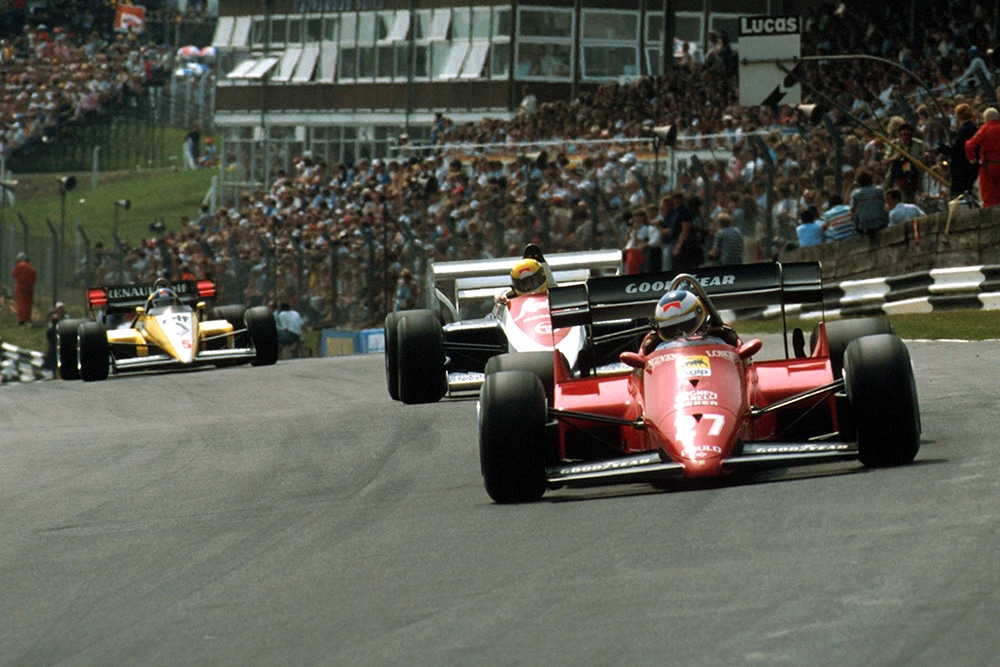
Michele Alboreto (Ferrari 126C4) leads Ayrton Senna (Toleman TG184).
© Motorsport Images
Some of the cars stopped on the starting grid, others went into the pit lane, and the whole British Grand Prix and all its razz-a-ma-razz fizzled out. While they were at it the organisation gathered up all the other wrecks around the circuit, dusted and polished the barriers, re-erected tyre walls and Armco, and generally tidied the place up. The re-start was scheduled to take place after the repairs and another 20-minute count-down, with the survivors lining up in the order they were in on lap 11 when Palmer caused the race to be stopped, which meant that Piquet was back on pole-position and he was allowed to fit a new set of tyres. The ATS had been retrieved, and made ready to restart but was refused permission as it had officially retired in the first part. Fabi and Rosberg could have rejoined, being in the pits at the time of the stoppage, but neither car could be revived, so 19 cars took the restart.
Somehow all the life had now gone out of the event, and the interest too, for the overall result was going to be based on the addition of times for the first 11 laps and the subsequent 60 laps which were about to be run, makings total of 71. The original race had been scheduled for 75 laps, the missing four being absorbed by various regulations. Prost took the lead of the re-start, followed by Piquet and Lauda, Warwick and Tambay, but as it was going to be one of those results that needed mathematics to decide the outcome, one could not get too excited, so activity along the way played a more important factor than the eventual outcome.
There were clearly three drivers who deserved to win this British Grand Prix and they were Piquet, Prost and Lauda, if anyone else was adjudged the winner at the end of it all it would be a travesty of justice. Warwick was clearly “the best of the rest” and doing a good job after two troubled practice days, and Ayrton Senna was showing that he was well able to play among the big boys. The young Brazilian was hounding de Angelis unmercifully, making the Italian driver think up all sorts of excuses about tyres, understeer, grip and similar things, whereas in fact he was driving hard and actually achieved his fastest lap of the race on the one before Senna did his fastest. The Toleman driver kept up the pressure all the way and took the Lotus on the run into Paddock bend in classic style on lap 69, just two before the end, at which point the Lotus “lost boost” on its Renault engine and was lucky to crawl round to the finish; Senna finished in a splendid third place, on the same lap as the winner.
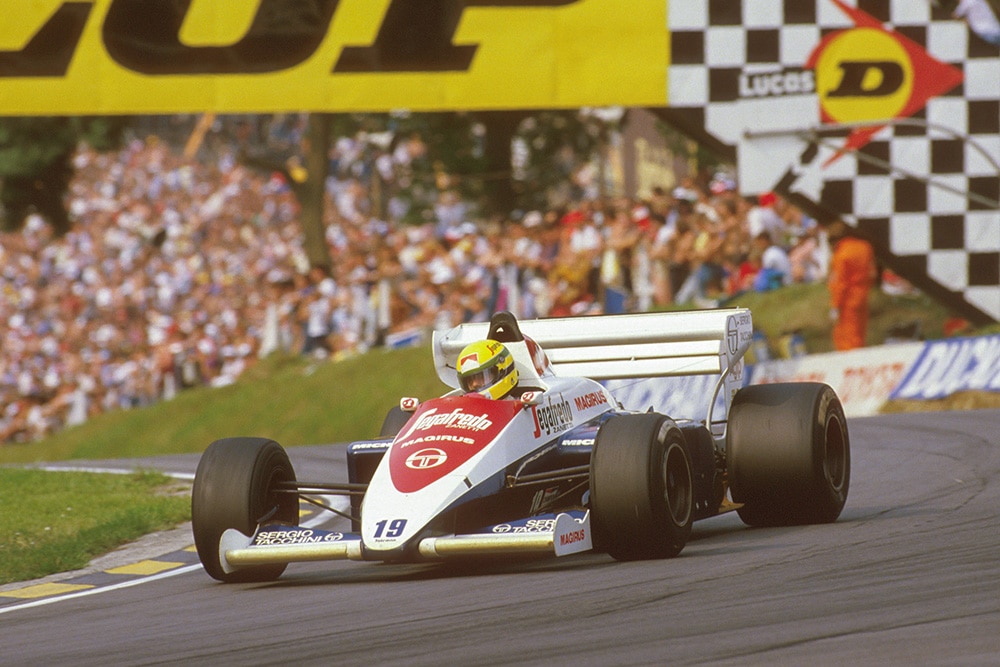
Ayrton Senna in his Toleman TG184 Hart at Druids.
© Motorsport Images
Justice prevailed up at the front for Lauda was the dominant winner, driving with all the smoothness and precision that has become his hall-mark, the McLaren MP4/2 running perfectly throughout. The wily old fox had never been more than a few metres away from the two young tear-aways ahead of him, passing Piquet on lap 29 and then formating on Prost in a very impressive one-two for the red and white cars from Woking and all points east to Weissach. On lap 38 Prost slowed dramatically and Lauda and Piquet went by and the natural leader went into the pits where he refired with gearbox problems. Towards the end Piquet’s BMW engine began to fade and eventually all the boost pressure had disappeared and he was reduced to as unsupercharged 1½-litre engine with which he struggled on to the finish, dropping from second place to seventh. Derek Warwick profited from this to move up into second place, a position well deserved after a good sound drive. Andrea de Cesaris managed to hold up both Ferraris for most of the race until Lauda sliced in amongst them as he lapped them, whereupon Alboreto out-fumbled his team-mate and the Ligier driver and began to go motor racing. On lap 52, de Cesaris spun at Druids, deranged the back end but continued slowly to finish a lowly 10th, leaving the Ferraris to finish an unimpressive fifth and sixth. Another “walking-wounded” at the end was Patrese’s Alfa Romeo which ground to a halt by the finish line with gearbox trouble, and Tambay’s Renault began to fail on the last lap and set itself on fire as it breasted the rise out of the stadium. Fires do not last long in British motor racing, for marshals were quickly on the spot to deal with it.
Niki Lauda chalked up his third British Grand Prix victory and his twenty-second overall and Ron Dennis, on behalf of his team said how happy he was for his Marlboro-sponsored team to have won the John Player-sponsored British Grand Prix! One should ask whether the RAC Motorsports Association try to do too much on the occasion of our premier motor sporting event? Would half the effort for half the cost perhaps provide an equally enjoyable event for half the people? The very knowledgeable and enthusiastic crowd gave Derek Warwick a huge ovation as he finished second and a similar one for Ayrton Senna.
The vast three-day spectacular really fizzled out when the final race of the day, for Formula Ford, had to be stopped and abandoned due to a nasty accident involving two drivers. A sad note to end on. — D.S.J.
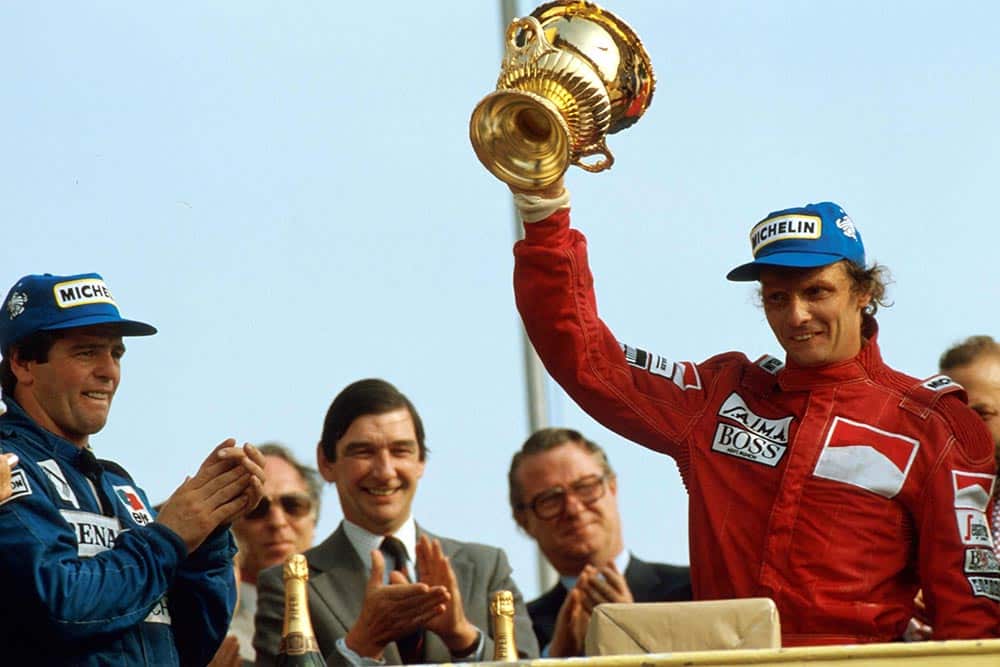
Niki Lauda on the podium.
© Motorsport Images
Results
British Grand Prix — Formula One — 71 laps — Brands Hatch — 4.206 kilometres per lap — 298.626 kilometres — warm — Two part race — 11 laps + 60 laps.
1st : Niki Lauda …………………………………….(McLaren MP4/2-1)………… 1 hr 29 min 28.532 sec — 200.212 kpn
2nd : Derek Warwick …………………………….(Renault RE50/08) …………..1 hr 30 min 10.655 sec
3rd : Ayrton Senna ………………………………..(Toleman TG184/02)………. 1 hr 30 min 31.860 sec
4th : Elio de Angelis ……………………………….(Lotus 95T/03) ……………….1 lap behind
5th : Michele Alboreto ………………………….(Ferrari 126C4/076) …………1 lap behind
6th : Rene Arnoux ………………………………….(Ferrari 126C4/075) ………..1 lap behind
7th : Nelson Piquet ………………………………..(Brabham BT53/4) ………….1 lap behind
8th : Patrick Tambay ………………………………(Renault RE50/07) …………2 laps behind — not running at finish
9th : Piercarlo Ghinzani ………………………….(Osella FA/1F-02) …………..3 laps behind
10th : Andrea de Cesaris …………………………(Ligier JS23/04) ……………..3 laps behind
11th : Stefan Bellof ………………………………..(Tyrrell 012/5) ……………….3 laps behind
12th : Marc Surer …………………………………..(Arrows A7/1) ……………….4 laps behind h
13th : Riccardo Patrese …………………………..(Alfa Romeo 184T/03) …….5 laps behind — not running at finish
14th : Huub Rothengatter ……………………….(Spirit 101/B2) ………………9 laps behind — not classified
15th : Francois Hesnault ………………………….(Ligier JS23/02) retired on lap 44 — engine failure
16th : Alain Prost ……………………………………(McLaren MP4/2-2) retired on lap 38 — gearbox
17th : Nigel Mansell ………………………………..(Lotus95T/02) retired on lap 25 — gearbox
18th : Thierry Boutsen ……………………………..(Arrows A7/2) retired on lap 25 — engine trouble
19th : Jacques Laffite ……………………………….(Williams FW09B/3) retired on lap 15 — engine trouble
20th : Jonathan Palmer …………………………….(RAM 02/02) retired on lap 11 –accident
21th : Teo Fabi ………………………………………..(Brabham BT53/2) retired on lap 10 — electric trouble
22nd : Manfred Winkelhock ………………………(ATS-D7/1) retired on lap 9 — spun off
23rd : Keijo Rosberg …………………………………(Williams FW09B/1) retired on lap 6 — engine trouble
24th : Stefan Johansson ……………………………(Tyrrell 012/4) retired on lap 1 — accident
25th : Eddie Cheever ………………………………..(Alfa Romeo 184T/02) retired on lap 1 — accident
26th : Philippe Alliot …………………………………(RAM 02/03) retired on lap 1 –accident
27th : Jo Gartner ………………………………………(Osella FA/1 F04) retired on lap 1 –accident
Fastest lap: Niki Lauda (McLaren MP4/2-1) on lap 57 in 1 min 13.181 sec — 206.837 kph
27 starters — 13 finishers
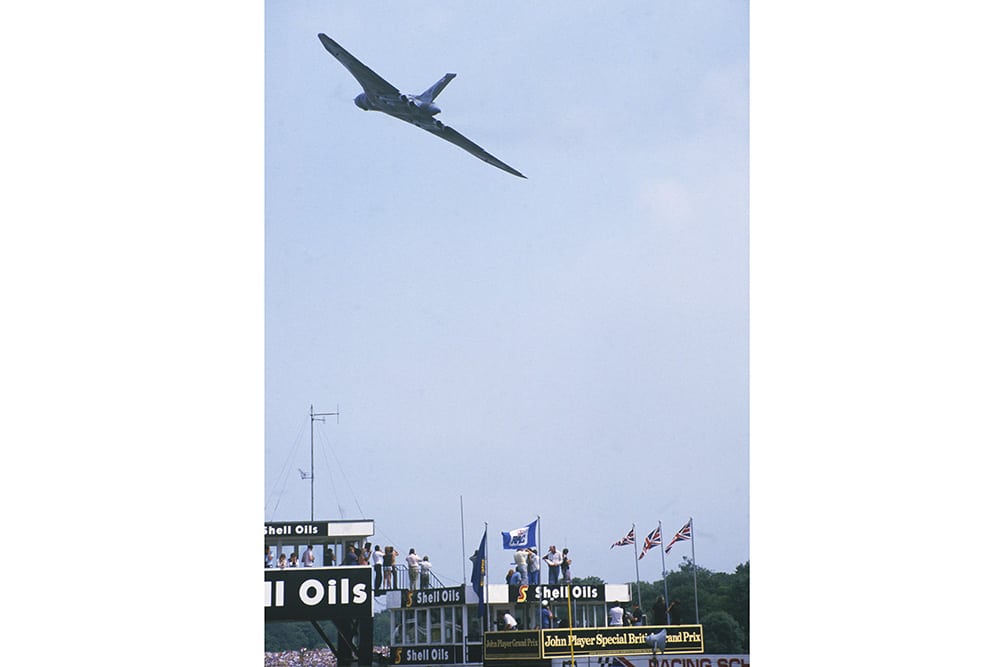
Avro Vulcan flying demonstartion before the race.
© Motorsport Images
